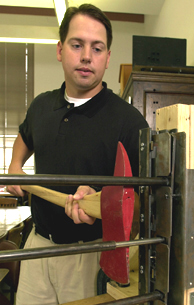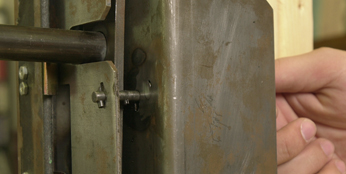
News Release
|
Office of News and Information Johns Hopkins University 3003 N. Charles Street, Suite 100 Baltimore, Maryland 21218-3843 Phone: (410) 516-7160 | Fax (410) 516-5251 |
June 1, 2001 FOR IMMEDIATE RELEASE CONTACT: Phil Sneiderman prs@jhu.edu |
from Deadly Falls
Undergrads' Device Deters Burglars but Allows
Easy Entry by Firefighters
A high-rise apartment. A wide-open window. A curious child.
Put them together and you have a recipe for disaster. Each year, falls from windows with and without screens kill more than a dozen children throughout the United States and send nearly 5,000 others to emergency rooms for treatment, according to federal researchers.
To avert such injuries, two Johns Hopkins undergraduates have invented a new type of locking window guard that can be opened from the inside by adults but not young children. From the outside, the gate allows easy entry by emergency crews, including firefighters, but it sounds an alarm if a burglar tries to break in.
Mike Barnard, 22, of Pittsburgh, and Howard Ku, 23, of Hong Kong, designed and built the prototype during a two-semester course in which students tackle real-world engineering assignments, working within maximum budgets of $6,000 to $8,000. (The students came in well below their budget, spending only about $4,000.) Barnard, a mechanical engineering major, and Ku, a dual major in civil engineering and engineering mechanics, completed the project just before their recent graduation from Johns Hopkins.
 |
|
In an undergraduate engineering class, Mike Barnard and
Howard Ku designed a safety gate to keep young children
from falling out of high-rise apartment windows. Photo by Jay Van Renssalear |
The window guard project was launched last fall with funding and a challenge from the Center for Injury Research and Policy at The Johns Hopkins University Bloomberg School of Public Health. "Mike and Howard did an excellent job," said Andrew E. Lincoln, assistant research professor at the center, who recently accepted the finished window gate. "One of the things we were particularly proud of was the way they handled some of the conflicting challenges. Their gate is accessible to adults but not to young children. It has a burglary deterrent but is also accessible to firemen. That's important because injury-prevention experts want to see window guards in place, but to firefighters, the guards are a large obstacle. This was an attempt to come up with something that was a happy medium for both sides."
 |
|
Mike Barnard uses an axe to show how firefighters could
easily open the window guard from the outside. Photo by Jay Van Renssalear |
To accomplish this goal, the students devised a hinged steel gate that swings open into the apartment when a spring-mounted bolt is released. The bolt is equipped with two prongs that help it function as a "key." Before it allows the gate to open, the bolt must be turned twice to allow the prongs to slip past their housing. Pulling the spring and maneuvering the bolt is easy for adults but requires finger strength and mental skills that should make it extremely difficult to open for children younger than 9 - - the age group most at risk for accidental window falls.
Although young children should be unable to open the window guard, Barnard and Ku designed the gate so that it snaps open easily from the outside if a firefighter strikes the bars with an axe. Any forced entry from the outside causes a loud alarm -- powered by a 9-volt battery -- to sound. This noise should send away any burglar who uses the same technique to enter, the student inventors said.
 |
|
From inside a home, a bolt with two prongs at the end serves
as the window gate's "key." It can be easily manipulated by
parents, but not by young children. Photo by Jay Van Renssalear |
The students and their sponsors at the Center for Injury Research and Policy plan to patent the window guard and look for a possible licensing agreement with a manufacturer who could mass produce the device. If manufactured in large quantities, the childproof window gate might cost consumers about $175 each, the students estimate. They say the gate is easily installed with seven mounting screws.
The childproof window guard was one of 12 Johns Hopkins projects completed this year by undergraduates in the Department of Mechanical Engineering's Senior Design Project course. The class is taught by Andrew F. Conn, a Johns Hopkins graduate with more than 25 years of experience in public and private research and development. Each team of two or three students, working within budgets of up to $8,000, had to design a device, purchase or fabricate the parts, and assemble the final product. Corporations, government agencies and nonprofit groups provided the assignments and funding.
The course is traditionally a well-received hands-on engineering experience for Johns Hopkins undergraduates. "With our project," says Barnard, "we got to apply a lot of the things we learned, as opposed to just working with numbers. We learned a lot of valuable lessons." Adds Ku, "I didn't anticipate a lot of the minor details that came up while we were making this project. But I liked seeing how all the pieces came together."
Color images of the students and their window guard available; contact Phil Sneiderman.
|
Johns Hopkins Department of Mechanical Engineering |
|
Johns Hopkins University news releases can be found on the
World Wide Web at
http://www.jhu.edu/news_info/news/ Information on automatic e-mail delivery of science and medical news releases is available at the same address.
|
 Go to
Headlines@HopkinsHome Page
Go to
Headlines@HopkinsHome Page